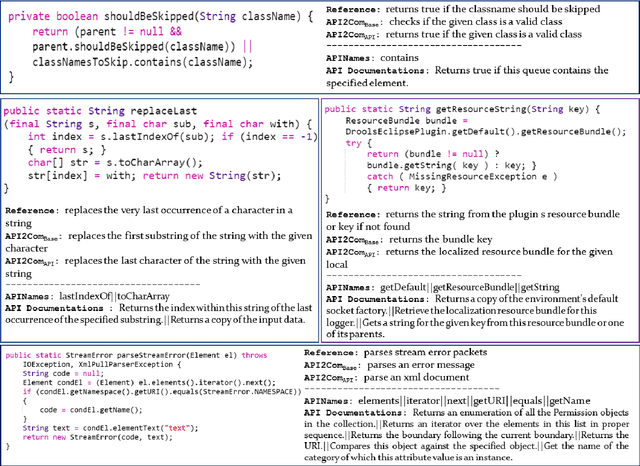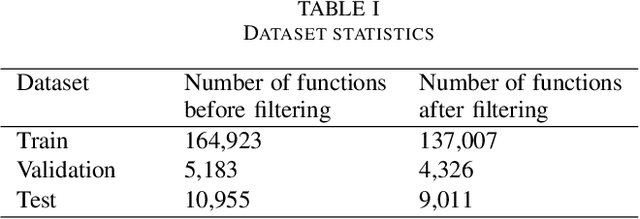Ramin Shahbazi
APIContext2Com: Code Comment Generation by Incorporating Pre-Defined API Documentation
Mar 03, 2023Abstract:Code comments are significantly helpful in comprehending software programs and also aid developers to save a great deal of time in software maintenance. Code comment generation aims to automatically predict comments in natural language given a code snippet. Several works investigate the effect of integrating external knowledge on the quality of generated comments. In this study, we propose a solution, namely APIContext2Com, to improve the effectiveness of generated comments by incorporating the pre-defined Application Programming Interface (API) context. The API context includes the definition and description of the pre-defined APIs that are used within the code snippets. As the detailed API information expresses the functionality of a code snippet, it can be helpful in better generating the code summary. We introduce a seq-2-seq encoder-decoder neural network model with different sets of multiple encoders to effectively transform distinct inputs into target comments. A ranking mechanism is also developed to exclude non-informative APIs, so that we can filter out unrelated APIs. We evaluate our approach using the Java dataset from CodeSearchNet. The findings reveal that the proposed model improves the best baseline by 1.88 (8.24 %), 2.16 (17.58 %), 1.38 (18.3 %), 0.73 (14.17 %), 1.58 (14.98 %) and 1.9 (6.92 %) for BLEU1, BLEU2, BLEU3, BLEU4, METEOR, ROUGE-L respectively. Human evaluation and ablation studies confirm the quality of the generated comments and the effect of architecture and ranking APIs.
API2Com: On the Improvement of Automatically Generated Code Comments Using API Documentations
Mar 19, 2021



Abstract:Code comments can help in program comprehension and are considered as important artifacts to help developers in software maintenance. However, the comments are mostly missing or are outdated, specially in complex software projects. As a result, several automatic comment generation models are developed as a solution. The recent models explore the integration of external knowledge resources such as Unified Modeling Language class diagrams to improve the generated comments. In this paper, we propose API2Com, a model that leverages the Application Programming Interface Documentations (API Docs) as a knowledge resource for comment generation. The API Docs include the description of the methods in more details and therefore, can provide better context in the generated comments. The API Docs are used along with the code snippets and Abstract Syntax Trees in our model. We apply the model on a large Java dataset of over 130,000 methods and evaluate it using both Transformer and RNN-base architectures. Interestingly, when API Docs are used, the performance increase is negligible. We therefore run different experiments to reason about the results. For methods that only contain one API, adding API Docs improves the results by 4% BLEU score on average (BLEU score is an automatic evaluation metric used in machine translation). However, as the number of APIs that are used in a method increases, the performance of the model in generating comments decreases due to long documentations used in the input. Our results confirm that the API Docs can be useful in generating better comments, but, new techniques are required to identify the most informative ones in a method rather than using all documentations simultaneously.
 Add to Chrome
Add to Chrome Add to Firefox
Add to Firefox Add to Edge
Add to Edge